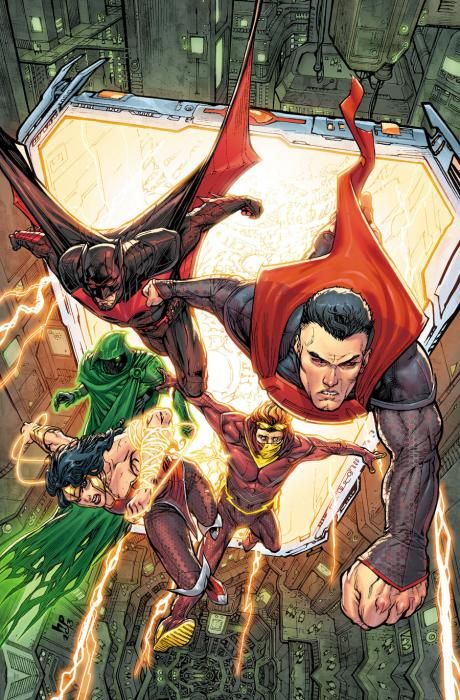Combining pieces of the creative teams from the successful 1980s and 1990s relaunches of the Justice League brand, "Justice League 3000" #1 prepares for the future by studying the past with writers Keith Giffen and J.M. DeMatteis with art from Howard Porter. Set in the far-flung future with a commonwealth civilization that is trying to recover from an attack by "The Five," this comic book gets rolling with action and then starts building up the characters.
Initially, I was ready to dismiss "Justice League 3000" #1 as a pale version of Justice League Beyond or a cardboard cutout excuse standing in for the Legion of Super-Heroes, but then I got to wondering if maybe "Justice League 3000" could be the refuge for fan favorite characters that simply haven't appeared yet. After all, this Flash has reddish hair and green eyes, like Wally West. This Wonder Woman could, conceivably, be Donna Troy, right? Not so much. Giffen and DeMatteis make it quite clear that the work of Cadmus has something to do with the 3000 League's existence.
The Cadmus-fueled Justice League in the pages of "Justice League 3000" #1 is fueled by in-fighting and sniping not unlike the "Forever Evil's" Crime Syndicate. From the start it feels a little old and unimaginative, but the fluidity of the League's situation makes them slightly more interesting than mere ciphers. Shepherding the League on behalf of Cadmus are two characters, brother and sister, named Teri and Terry -- the Wonder Twins -- who have a vested interest in the team more as an experiment than colleagues. The Wonder Twins add more to this title than the League itself. The Wonder Twins play off the enigmatic, critical, introductory character introduced in "Justice League 3000" #1's first scene -- Ariel Masters -- whose differently colored caption boxes project her beyond the milieu of the rest of the story. It all adds up to a different take, to be certain, but the writers need to ensure the story has some speed behind its construction or they run the risk of losing readers to indifference if infighting is the driving force for this comic.
Far-flung, harshly used futures lend themselves quite nicely to Howard Porter's art style. Filled with detail that adds texture more than design, Porter's drawings depict used items and lived-in places. Porter has a flawless knack for adding more detail as the panels close in on characters, but still maintains the essence of the character from far away, when details blur into smoothness, not unlike the effect of unfocusing a camera or a near-sighted person removing their glasses. Hi-Fi's colors fill Porter's art nicely, adding to the used, roughed up quality of Bradbury 7, this new world that is the setting for "Justice League 3000" #1.
Having experienced a dynamic shift in expectations from the first mention of this book (which was initially announced with Kevin Maguire in the artist's chair) to reading it, I find "Justice League 3000" to be incomplete. There are good things and bad things about this issue. There's excitement and apathy aplenty. We've seen some of this before -- some of it quite recently, in fact -- and there are also some nice new pieces, like Bradbury 7. Overall, though, "Justice League 3000" #1 is safe; it's not disappointing, but it's also not impressive; it's intriguing, but not captivating. "Justice League 3000" #1 has some good structural components, but it needs to give readers a little more to work with than the "Elseworlds"-lite feel this first issue delivers.

